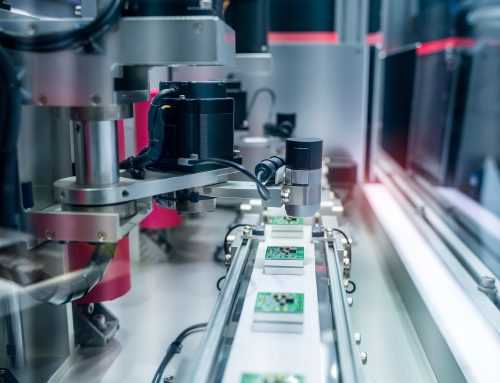Despite the challenging global economic environment, the electronics industry has held its own in 2023.
With growth in most electronic sectors comfortably outpacing nearly all global economies, there is good reason to be optimistic for the future for those in the electronics industry. Now, for original equipment manufacturers (OEMs), electronic product designers and businesses alike, the actual test in 2024 will be keeping up with the relentless evolution of technology that continues to reshape our world.
From the development of 6G connectivity and a rise in smart technology to the expansion of virtual and augmented reality and machine learning tools, 2023 taught us that adapting to upcoming trends is essential for anyone aiming to lead the charge.
With that in mind, what do we expect will dominate the electronics manufacturing industry in the new year?
1. Generative artificial intelligence (AI)
In 2023, generative AI exploded onto the scene. By enabling machines to create content resembling human-generated work, this technology is opening doors to exciting opportunities across every sector.
So, how will the electronics industry adopt generative AI in 2024?
One field poised for an AI revolution is electronic design. Over the years, electronic design automation (EDA) tools have been flaunting the integration of AI into their offerings. Still, these have mostly fallen short of the ultimate goal: making hardware easier to design.
With evolving chat-based generative AI tools like Copilot, designers and manufacturers can utilise technologies that understand the entire context of a project. Alongside its training, generative AI platforms can use that information to provide designers with advice, feedback and comprehensive analysis.
For example, a generative AI could eliminate the need for datasheet and part research and simply tell the designer what parts they should use in their project. In the new year, electronics designers and manufacturers may finally have the tools they need to take the ‘hard’ out of hardware…
2. Quantum computing
As technology advances at an unprecedented rate, so does our need for more efficient and powerful electronic devices. Traditional silicon-based electronics have served us well, but they are reaching their limits — which is where molecular engineering comes in.
Molecular engineering harnesses the power of designing and manipulating molecules at the nanoscale to create new materials.
But where does quantum computing come into the equation?
Quantum computing is an evolving technology that exploits the laws of quantum mechanics to crack problems too complex for classical computers. When working with molecular engineering, researchers can fast-track the discovery of new materials with unique properties for electronic productions — like higher conductivity or improved energy storage capabilities.
For manufacturers, realising new materials promises higher performance and efficiency, unlocking exciting possibilities for the electronics industry.
3. Wearable devices
2023 saw remarkable strides made in the wearable technology industry. Thanks to a fusion of innovation and practicality, consumers and manufacturers alike have been introduced to a new era — where wearables are not just accessories but indispensable tools that seamlessly integrate into our daily lives.
So, where will these technologies go in 2024?
It seems augmented reality (AR) wearables will be taking centre stage. The integration of AR into smart glasses, helmets and even contact lenses aims to transform how we perceive and interact with the world.
For consumers, an example of these advances could be receiving real-time information about the landmarks around them. For OEMs, AR in wearable tech could improve the health and safety of production processes — monitoring work conditions (like heat stress, potential hazards or equipment malfunctions) and alerting employees to any missed safety procedures to keep them safe on the job.
Moving on from conventional wearable devices, 2024 is also set to see the spread of smart fabrics. From shirts that monitor vital signs to socks that track motion, advanced technology will be seamlessly woven into the very fabric of our clothing, making it more intuitive and less intrusive in our daily lives.
4. Digital twins
Any electronics manufacturer or OEM will understand the frustration of unexpected downtimes and maintenance mishaps. Luckily, 2024 could be the year we say hello to the power of digital twins and goodbye to operational inefficiency…
A digital twin is, in essence, a computer program that uses real-world data to create simulations that can predict how a product or process will perform. These programs are increasingly integrating the internet of things (IoT), artificial intelligence and sensors to create virtual representations in the digital realm.
As we enter the new year, OEMs and electronic designers will rely more on digital twins for safe experimentation and optimisation, leading to better products and more efficient production methods. In fact, the IMARC Group expects the market to reach $156.7 billion by 2032.
With a need for speed in today’s competitive electronics industry, digital twin technologies will lend manufacturers a crystal ball — giving them valuable insight into the future of their processes and allowing them to stay one step ahead of the competition.
5. Sustainable technology
As countries, businesses and manufacturers continue to work on meeting net-zero commitments, we predict sustainable technology will continue to dominate in 2024.
Take smart cities. By harnessing the power of the IoT and data analytics, smart cities can monitor and manage various aspects of city life — from traffic and energy consumption to air quality. Electric vehicles (EVs) have also become more affordable and widespread, reducing greenhouse gas emissions and our dependence on fossil fuels.
For OEMs, closing the loop with a circular economy will remain important as durability, recyclability and reusability are built directly into products at the design stage.
Reaching a circular economy will be less than straightforward, but upwards of 70% of consumers would pay an additional 5% for a green product. Throughout 2024 and beyond, new electronic products must be designed with materials suitable for reuse and safe recycling, whilst waste from previous electrical and electronic equipment (EEE) should be appropriately disposed of or recycled.
We keep our finger on the pulse of the electronics industry to ensure we provide the most up-to-date electronics manufacturing services. To discuss how we can help with your next project, contact us at +44 (0)1256 461894 or email sales@ecelectronics.com.









